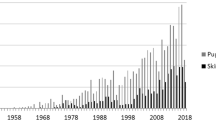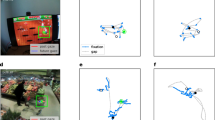Summary
Ocular counterrolling (OCR) has previously been studied using static head tilt or continuous rotation about the line of sight as a stimulus to the otolith organs. This study presents the first measurements of OCR in humans induced by linear accelerations. Dynamic measurements of the response to lateral linear acceleration indicate the eye movements to be on the order of 2 ° for 0.2 g peak acceleration, 0.2 Hz sinusoidal acceleration. These values are consistent with static OCR studies. The dynamics of the response are similar to a low order linear system with a dominant time constant of 0.33 s. A previous model predicts a time constant of 0.32 s. Sinusoidal oscillation at 0.2, 0.4, and 1.0 Hz with a 0.2 g peak acceleration showed good agreement with the model in both gain and phase. The question of amplitude linearity remains unsettled. This otolithocular reflex, over short periods at least, appears to be stationary in the statistical sense.
Similar content being viewed by others
References
Arrott AP (1981) Torsional eye movements in man during linear accelerations. S.M. Thesis, MIT, Cambridge, MA
Balliet R, Nakayama K (1978) Training of voluntary torsion. Invest Ophthalmol Vis Sci 17: 303–314
Baarsma EA, Collewijn H (1975) Eye movements due to linear acceleration in the rabbit. J Physiol (Lond) 245: 227–241
Chassen MH, Guthrie JW, Replogle CR, Junker AM (1971) Investigation of the primate vestibular system function through analysis of the vestibulo-ocular reflex response to various input stimuli, AMRL-TR-71-4. Aerospace Medial Research Laboratory, Wright-Patterson AFB, OH
Cohen B, Krejcove H, Highstein S (1970) Ocular counterrolling induced by static head tilt in the monkey. Fed Proc Abstr 29: 454
Colenbrander A (1963) Eye and otoliths. Aeromed Acta 9: 45–91
Diamond SG, Markham CH, Simpson NE, Curthoys IS (1979) Binocular counterrolling in humans during dynamic rotation. Acta Otolaryngol (Stockh) 87: 490–498
Edelman ER (1979) Video based monitoring of torsional eye movements. S.M. Thesis, MIT, Cambridge, MA
Fender DH (1955) Torsional motions of the eyeball. Br J Ophthalmol 39: 65–72
Fernandez C, Goldberg JM (1976) Physiology of peripheral neurons innervating otolith organs of the squirrel monkey. III. Response dynamics. J Neurophysiol 39: 996–1008
Fluur E (1975) A comparison between subjective and objective recording of ocular counterrolling as a result of tilting. Acta Otolaryngol (Stockh) 79: 111–114
Galoyan VR, Zenkin GM, Petrov AP (1976) Investigation of the torsional movements of human eyes. II. Slow phase of torsion. Biofizika 21: 1081–1086
Hannen RA, Kabrisky M, Replogle CR, Hartzier VL, Roccaforte PA (1966) Experimental determination of a portion of the human vestibular response through measurement of eyeball counterroll. IEEE Trans Biomed Eng 13: 65–70
Howard IP, Templeton WB (1966) Human spatial orientation. Wiley, London
Junker AM, Replogle CR, Smiles KA, Brown RP, Wheeler RH (1971) Analysis of the vestibulo-ocular counterroll reflex in primates. AMRL-TR-71-59. Aerospace Medical Research Laboratory, Wright-Patterson AFB, OH
Kamada O, Sato K, Kitmura S, Nakamura H (1976) Two automatic methods of measuring the counterrolling of human eyes. Digest condense of the 11th International Conference on Medical and Biological Engineering. Ottawa, Canada, pp 510–511
Kanzaki J (1975) New device for measurement of ocular countertorsion reflex. Arch Otorhinolaryngol 211: 213–215
Kellogg RS (1965) Dynamic counterrolling of the eye in normal subjects and in persons with bilateral labyrinthine defects. The role of the vestibular organs in the exploration of space. NASA sp-77, pp 195–202
Kompanejetz S (1928) Investigation on the counterrolling of the eyes in optimum head positions. Acta Otolaryngol 12: 332–350
Lichtenberg BK (1979) Ocular counterrolling induced in humans by horizontal accelerations. Sc.D. Thesis, MIT, Cambridge, MA
Linwong M, Herman SJ (1971) Cycloduction of the eyes with head tilt. Arch Ophthalmol 85: 570–573
Macadar O, Wolfe GE, O'Leary DP, Segundo JP (1975) Response of the Elasmobranch Utricle to maintained spatial orientation, transitions and jitter. Exp Brain Res 22: 1–13
Miller EF II (1962) Counterrolling of the human eyes produced by tilt with respect to gravity. Acta Otolaryngol (Stockh) 54: 479–501
Miller EF II, Graybiel A (1971) Effect of gravito-inertial force on ocular counterrolling. J Appl Phys 31: 697–700
Nelson JR, Cope D (1971) The otoliths and the countertorsion reflex. Arch Otolaryngol (Stockh) 94: 40–50
Petrov AP, Zenkin GM (1973) Torsional eye movements and constancy of the visual field. Vision Res 13: 2465–2477
Robinson DA (1963) A method of measuring eye movement using a scleral search coil in a magnetic field. IEEE Trans Biomed Eng 10: 137–145
Smiles KA, Hite D, Hyams VJ, Junker AM (1975) Effects of labyrinthectomy on the dynamic vestibulo-ocular counterroll reflex in the Rhesus monkey. Aviat Space Environ Med 46: 1017–1022
Suzuki J, Cohen B, Bender MB (1964) Compensatory eye movements induced by vertical semicircular canal stimulation. Exp Neurol 9: 137
Walton WG (1948) Compensatory cyclotorsion accompanying head tilt. Am J Optom 25: 525–534
Woellner RC, Graybiel A (1959) Counterrolling of the eyes and its dependence on the magnitude of gravitational or inertial force acting laterally on the body. J Appl Physiol 14: 632–634
Young LR, Meiry JL (1968) A revised dynamic otolith model. Aerosp Med 39: 606–608
Author information
Authors and Affiliations
Additional information
Supported by NASA Grants NSG 2032, NAG 2–88 and NAS9–15343
Recipient of a Fannie and John Hertz Foundation Fellowship for his Sc.D. studies
Rights and permissions
About this article
Cite this article
Lichtenberg, B.K., Young, L.R. & Arrott, A.P. Human ocular counterrolling induced by varying linear accelerations. Exp Brain Res 48, 127–136 (1982). https://doi.org/10.1007/BF00239580
Received:
Revised:
Issue Date:
DOI: https://doi.org/10.1007/BF00239580




